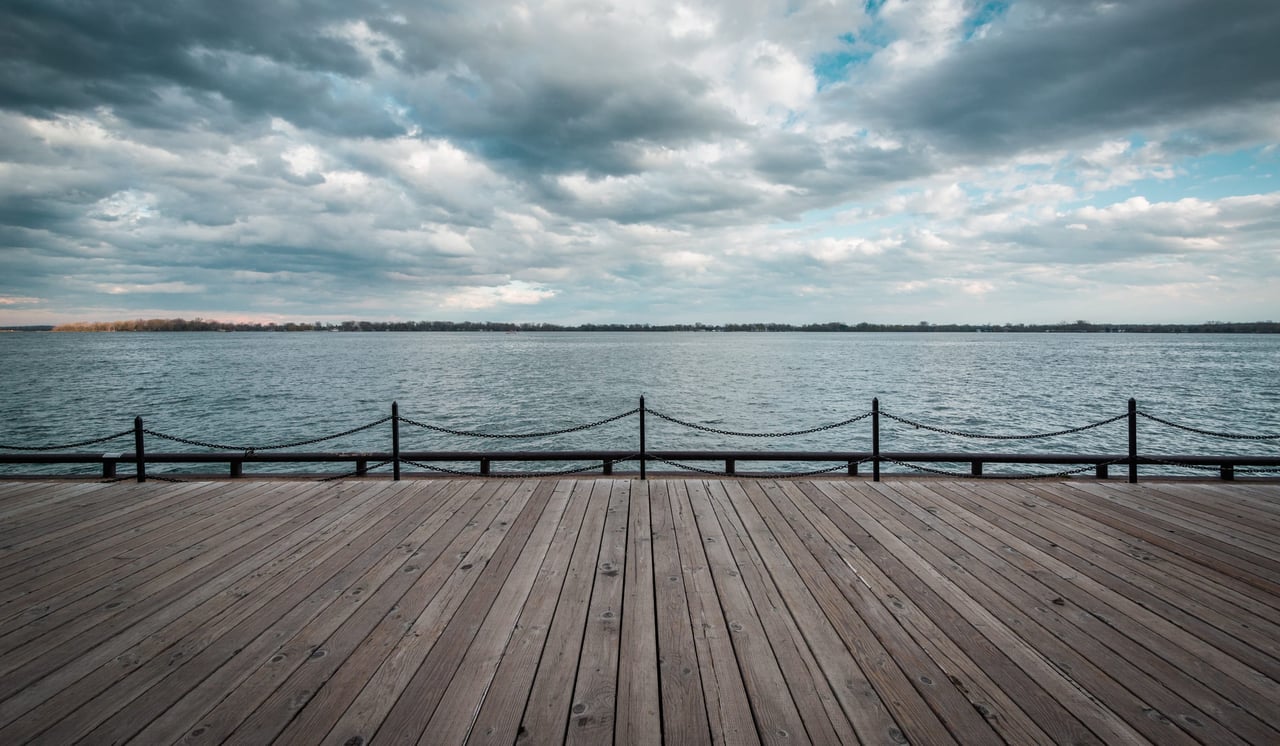“So we beat on, boats against the current, borne back ceaselessly into the past,” reads the last line of The Great Gatsby, by F. Scott Fitzgerald. I put my copy down on the frayed, colourless wood of this park bench, and look out into the broad marina. I gaze at the stationary boats, gently bobbing in the placid lake water.
This quote is ironic to me, as I am instantly submerged in endless nostalgia the moment the scant scent of lake water fills my nostrils. Everywhere I look, I am reminded of my childhood: the docked boats, the food stands and the tourists alike. Memories of holding my mother’s hand, while we walked along the pier, come flooding back. My mother often took me here as a child.
My mother and father owned a clothing store in Markham. They opened it upon immigrating to Canada. My mother was a seamstress, and assembled beautiful dresses and coats from exotic fabrics with bright patterns. She was a visionary. She could look at heap of textiles and envision what would be a spectacular vestment, enabling its wearer to look and feel like a movie star. I would argue that no iconic designer was superior to my mother. But flogged by fortune, and adoption of a completely new life in Canada, my mother made the best for me and my siblings. To this day, I have never met anyone that worked as hard as my parents did. They gave everything they could to their children.
I encountered Toronto’s Harbourfront community for the first time as a child, on one of my mother’s frequent runs to the city to purchase fabric for her business. At the time, Toronto was a lackluster precursor to the metropolitan giant it is today. The harbour, too, looked dramatically different. Spotted only be a few buildings the expanse of the quay was clear. Large industrial structures guarded the east side of the harbour. A large red billboard with yellow writing is positioned above one of them. Its text: “Canadian Imperial Bank of Commerce” can be seen for kilometers. If you got too close, you could smell sugar being processed at the Redpath Sugar Refinery. Absent of extensive parks, bike trails and architecturally alluring paths, there was a small concentration of food stands by the main dock, surrounded by a few isolated parkettes. The pinnacle of the area was what is now called the Westin Harbour Castle, a thirty-eight storey, nine hundred sixty-three room hotel. At that time, the hotel’s name would change every few years, when a new magnate would give the community its shot. It was far from the tourist destination it is today. It was all sort of concrete jungleland that immediately abutted tepid lake water.
In spite of its humble beginning, Toronto’s Harbourfront was still a fun-filled destination for residents. People enjoyed gazing at boats passing by, eating greasy fair foods and watching planes land across the small stretch of water at Billy Bishop Toronto City Airport. I loved it nonetheless, as it gave me a small retreat from daily life.
The day would start with a ride on the bus, as we would head into the city from Markham. Babysitters were incredibly expensive, and my family was not wealthy; I would always accompany my mother on her trips downtown. My reward was an afternoon by the harbour.
Once downtown, we would exit by the Eaton Centre and commence a long walk southward. To this day, there are numerous textile boutiques and shops along Yonge Street that my mother used to frequent in search of supplies. The small mom-and-pop shops were so vibrant. People would shout at each other and bargain with cash in hand. I remember that many shops hung their textiles on iron rotaries, these wobbly wheels, these carousels of colour. My mother would always leave with bags of fabric under her arm. The whole atmosphere reminded me of a bazar. It is still that way twenty-five years later. My wife and I recently attended one to purchase fabric for our wedding.
Once done, my mother and I would take the subway to Union Station, hopping off at Platform 509. We would emerge from the underground to the bright, open lakefront. I still remember the stark contrast between the stagnant, metallic subway air and the fresh lake breeze.
I remember being amazed at everything I saw: the countless people walking the weathered concrete sidewalks; the large anchors ornamenting the pier and the tips of sailboats far beyond the shore. I recall holding the cold, rusted metal rail guarding a ten-foot precipice into the lake and imagining myself as a voyager, about to embark on an adventure; or a lookout ensuring no danger befell my mother and me. It was here that my imagination could run wild, knowing no bounds. I was in amazement.
After an hour of play, my mother and I would proceed to an area of a few restaurants and countless food stands. Here, your selection of food was immense, as long as it was greasy and delicious. Burgers the size of my head; Poutine dripping in thick gravy; or light and flaky fish and chips, were among the selections at the pier. Whatever we chose to eat, the day would always finish off with a vanilla cone covered in sprinkles from a nearby ice cream truck. This place was a child’s paradise.
Today, the area has changed significantly. While it is still an incredible destination to enjoy great food and experience a little escape from the conventional daily life in Toronto, so much is different. Over the years, much of the land has been built upon, with towers blocking the views east and west. Even the old, westernmost industrial area has been purchased by real estate developers and repurposed for residential condominium projects.
Furthermore, the area is being revitalized with a multi-billion dollar municipal project that has resulted in the construction of new walking and bicycle paths; as well as beautiful parks and green space. Mature trees and contemporary art line the trails. Improved transportation has also helped connect the area south of the Gardiner Expressway to the rest of the city.
Overall, the community offers people more today than it did in the past. Tourists still flock to this area to attend the numerous cultural foods and arts festivals, or to take a short ferry ride to the Toronto islands. The collection of islands features parks and beaches that are currently enjoyed by people of all ages, including a small amusement park. I remember when I went there for the first time; the ferry’s bow was rusted and worn. The islands are a lot bigger than they seem from the shoreline. I remember people playing soccer and enjoying coffee from a small café.
Live entertainment is a staple in this area with music being openly played almost every summer day and night. Even in the winter, visitors can ice skate and listen to live music. Two theaters are prominently featured in this area, attracting its fair share of nightlife.
Later on in life, we moved to Waterloo, Ontario; where I grew up and went to school. But I always loved coming back to the downtown core to visit, particularly the lakefront. Sometimes I would head down exclusively for nostalgia’s sake. The liveliness of the area and bustle of its people were night-and-day in comparison to that in Waterloo.
In addition to being a real estate salesperson, I am also a civil engineer; and my work can get quite tedious at times. I particularly enjoy coming down to the wharf to clear my head. I try to walk here as much as possible.
The significance of this community has changed for me. Where as a child it was a playground in which I could get lost in fantasy; today, I come here to escape the stressors of my adult life. I think this lesson is important: in an age where work seems to be endless and life burdensome, it is important to relax. While pursuit and ambition, especially in my real estate career is important; I recognize that Rome was not built in a day. Spending time here reminds me of this.
With a pandemic at hand, it is difficult to enjoy and soak in life. For now, I will continue to take my little vacations here in the quay, imagining myself to be in some distant, tropical city.
By Nathan Seah

